There is widespread consensus among science education researchers that learning science should begin early in every child’s schooling. Among many good reasons, one stands out clearly: “Children naturally enjoy observing and thinking about nature”[1]. Several studies have shown that the public also wants science to be taught early. For example, in a recent public opinion research conducted for the Center for the Future of Teaching and Learning at WestEd, seven in ten Californians expressed the view that learning science in primary school is likely to increase the chances of students to perform well in high school[2].
In line with the above, several initiatives to engage primary school students have taken place in collaboration with CERN. These include the “Mains dans la pate” initiative of Georges Charpak in France, and the “Dans la peau d’un chercheur” project that is aimed at K-6 students from local schools.
Playing with Protons (PwP) is a new science education initiative led by the CMS Experiment that contributes to this effort by encouraging primary school teachers to engage in professional development (PD) opportunities. These are designed specifically to enrich teachers’ pedagogical practice with creative, hands-on methodologies by which K-6 students can, in turn, get engaged effectively with science, technology and innovation.
PwP was born out of the passion, dynamism and determination of Tina Nantsou, a physics educator at Hill Memorial School in Athens, Greece. Established in 1831, this is the oldest operating primary school in the country. In 2013, Tina visited CERN as a participant in the Greek Teacher Programme, and upon her return to Athens started a project in collaboration with CERN that involved forty-five 11-12 year old students at Hill Memorial School. And as you may have already guessed, the title Tina gave to her project was Playing with Protons. You can read more about it here and here.
Tina’s work attracted a lot of interest by the educational community and the media in Greece. The results of the project were also shared with prominent physicists, including Distinguished Professor of Physics and holder of the Mitchell/Heep Chair in High Energy Physics at Texas A&M University, and former President of the Academy of Athens, Dimitri Nanopoulos, and Clerk Maxwell Professor of Theoretical Physics at King’s College London, John Ellis. Over the last three years, both Prof. Nanopoulos and Prof. Ellis visited Hill Memorial School, met the students, answered their advanced questions and witnessed first-hand what effective engagement with physics looks like.
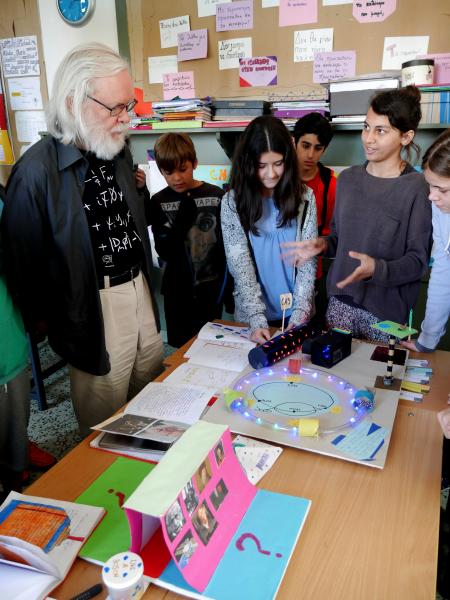
In response to this interest, it was considered meaningful to design a pilot PD course that would enable more teachers from public primary schools, and especially those schools located in islands and relatively underprivileged urban areas in Greece, to get familiar with the unique culture of science, technology and innovation at CERN, and to embrace creative approaches for passing on their newly acquired knowledge and enthusiasm to their pupils.
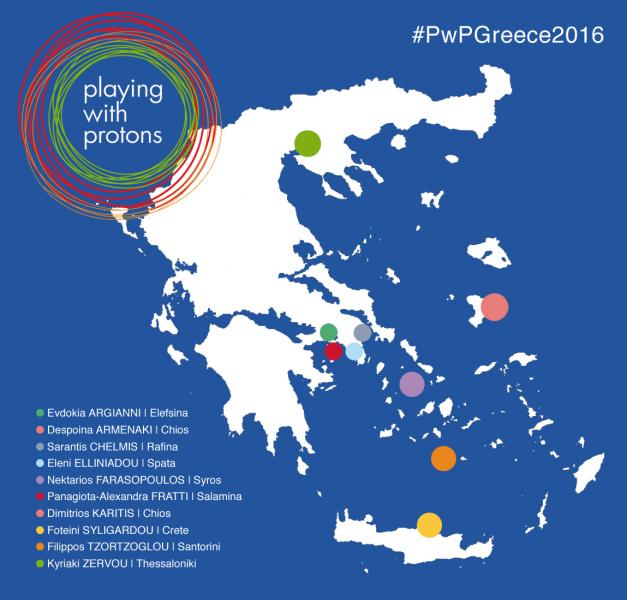
Thanks to synergies built between nonprofit organisation New Wrinkle, the industry[3], the Greek Ministry of Education and the European Commission Office in Athens, and under the umbrella of EU project CREATIONS, a fully self-funded PwP course became a reality this year for a small number of Greek primary school teachers. The 10 finalist teachers were selected by a committee at CERN from a total of 151 applications.
The course was hosted by CERN’s IdeaSquare from 17 to 22 August 2016, and based on participants’ written feedback we may securely say that it has been successful. This, of course, wouldn’t be possible without the support, enthusiasm and expertise of many colleagues from CMS and the wider CERN community. A big thank you to each and everyone of you! You know who you are!
And now, what better way to learn about this experience than from the teachers themselves? So, here is an interview I did with Elena Elliniadou and Filippos Tzortzoglou, two of the participants of PwP Greece 2016, soon after their return home from CERN.

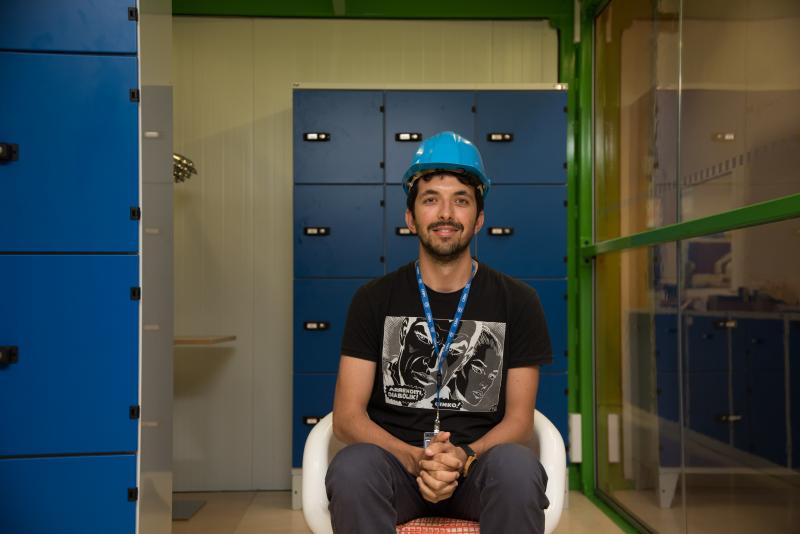
Can you tell me a few words about yourself and your school?
Εlena Εlliniadou: I’m the principal of the 6th Primary School of Artemis. This is a typical suburban school located at the east of Attica region in Greece. My school is under the same roof with the 2nd Primary School of Artemis, the principal of which is Mrs. Kassiani Katsiouli. Both schools have in total more than 400 K-6 students. Kassiani and I work closely together, which means that the two schools are effectively run as one. My participation in PwP will therefore have an impact not only on the 135 students of my school, but also on Kassiani’s students. I’m also an ICT teacher trainer and a blogger. In my blog I express my viewpoints on primary education and the role of ICT in it. I also share resources and materials that I think would help my colleagues learn how to build effective pedagogies for teaching various subjects, including of course science and technology.
Filippos Tzortzoglou: I’ve been working as a primary school teacher for the last eight years. I’ve been teaching in many schools across Greece most of which located in islands such as Kefalonia, Crete and Santorini. This September I’m going to teach in a small public primary school in Psinthos, a mountainous village at the island of Rhodes. I have great interest in ICT applications for education and especially in mobile applications for game-based learning and in augmented reality (AR), with the latter being the topic of my PhD research at the University of the Aegean. My passion for innovative technologies and their role in education have led in several interesting collaborations with companies specialized in this area. My latest passion is blogging. I’m the founder and author of EdTech.gr, where I share my experience with other teachers, school administrators and parents.
Why did you decide to apply to PwP?
EE: When I read the call for applications that was sent out last April by the Ministry of Education, I thought of PwP as an innovative course that would fill a notable gap in the professional development available to primary school teachers in Greece and, I guess, elsewhere. One extra reason was Tina Nantsou and her key role in the course as pedagogical coordinator. I follow Tina’s blog for many years now, and I admire the creative, hands-on methodologies through which she introduces her students into the world of physics. Participating in PwP would offer me, and my students as a consequence, a unique opportunity to create new, fun and impactful projects about particle physics and CERN with the aim to make science accessible to students by helping them discover how cutting-edge science actually works at the world’s largest particle physics lab. In addition, the course would help me answer my students’ questions about the Universe and its mysteries, with the ultimate aim to inspire them, to open their minds and their horizons as far as it concerns science, physics, particle physics and, of course, CERN. I believe that every kid should know how their everyday life is related to scientific discoveries and technological breakthroughs, some of which born at CERN.
FT: Taking part in PwP was an excellent opportunity for me to visit CERN, the Mecca of particle physics, to experience first-hand how scientific research is taking place there, and to meet scientists who have, in one way or another, contributed to discoveries such as the recent discovery of the Higgs boson. I also thought it would be a great opportunity to enrich my existing knowledge in the field so that I could update my students with the latest developments at one of the world’s greatest scientific experiments. When I applied to the course, I had one goal in mind: to inspire my students about all this, and to encourage them to dream that they can one day become members of the scientific community. In addition, I thought that seeing how all these scientists, engineers and technicians work together at CERN would be beneficial for my own PhD research.
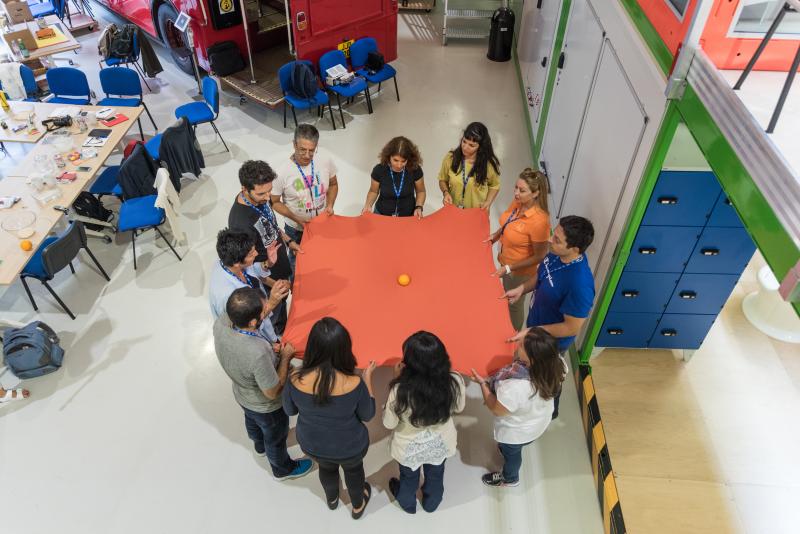
Now that the course is over, what will you bring back to your school, to your students and perhaps to your local community?
EE: I’ll try to pass on my passion and enthusiasm to my students and my colleagues, first by describing them my overall experience at CERN and, second, by working with them on various curriculum projects inspired by what I learned during the course. I’ll definitely tell everyone that there is a place called CERN, where diversity, equality and peace are not just accepted but celebrated. I’ll also tell them that there are no many places in the world that really push forward our understanding of where we come from, what we are made of, and where we are going, also as humanity at large. We, as teachers, have an obligation to help our students open their own paths to knowledge, science and life. What I – and I believe all the other teachers who took part in PwP – will do is to communicate to colleagues, students, parents and the local community what we experienced at CERN and how we can transform this experience into school projects, outreach events for the local community and learning networks, both physical and virtual.
FT: During my time at CERN, I met a lot of interesting people such as the fellow teachers who took part in the course, and a good number of CERN scientists. I definitely learned a lot by visiting remarkable experimental facilities and by experiencing first-hand the multicultural and vibrant culture of collaboration that makes CERN what it is. I’ll definitely share this experience with my school and the local community! I’ll tell them how enthusiastic and passionate the people I met are about their work in science and technology. I’ll then try to pass on my own enthusiasm and the new things I learned during the course to my students. A concrete way to do so is to try to incorporate ICT applications into new educational scenarios inspired by PwP, perhaps by making a mobile game or an AR application in order to motivate and guide my students in the right direction.
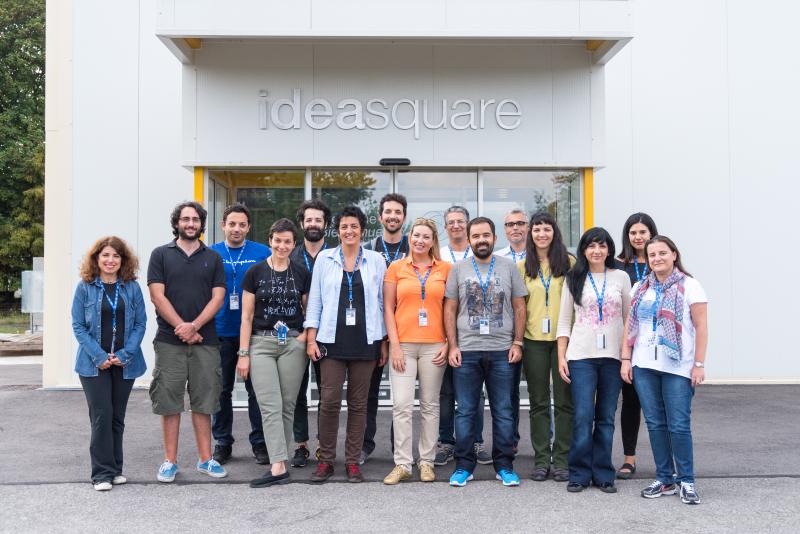
What are your personal highlights of this course?
EE: Being around brilliant scientists, both young ones and seniors, and feeling their passion and energy for what they are doing was something I hadn’t experienced before. John Ellis’ “Playing with the Universe” lecture, which was tailored to primary school teachers, was in particular truly amazing. I’ll also remember the visits and, of course, the afternoon hands-on workshops at IdeaSquare. My overall takeaway is that there is a purpose that runs through all that CERN scientists do, and that is to help us understand better the physical world and our place in it.
FT: I have to say that I enjoyed all the presentations and workshops. A personal highlight was François Briard’s talk about the “Dans la peau d’un chercheur” project. I think it’s a fantastic way to foster scientific reasoning in primary school students. Meeting applied physicists such as Andromachi Tsirou from CMS, but also theoretical physicists such as Asimina Arvanitaki from Perimeter Institute, was also really useful as it helped me understand where theory and practice meet in particle physics. And, of course, John Ellis’ talk was something else! I was also amazed by the visit to the CMS experiment, which made me realise the amount of human effort and sophisticated materials required to build a particle detector. This can only be possible when passionate and determined individuals work together. And this passion and determination, I think, is what makes CERN what it is.
Finally, if you could describe PwP in three words, what would they be?
EE: Innovative, inspirational, motivational.
FT: Fascinating, innovative, unique.

Footnotes:
[1] Eshach, H., & Fried, M. N. (2005). Should science be taught in early childhood? Journal of Science and Technology, 14(3): 315-336.
[2] Belden, N., Lien, C., & Nelson-Dusek, S. (2010). A priority for California's future: Science for students. Santa Cruz, CA: The Center for the Future of Teaching and Learning.
[3] PwP Greece 2016 was partially sponsored by Hellenic Petroleum S.A., Athens International Airport S.A. and Elpen Pharmaceutical Co. Inc.
Disclaimer: Playing with Protons is an education and outreach initiative of the CMS Experiment at CERN in the framework of CREATIONS project funded with the Horizon 2020 Framework of the European Commission under grant agreement no. 665917. This article reflects the views of the author and the Commission cannot be held responsible for any use which may be made of the information contained therein.
The views expressed in CMS blogs are personal views of the author and do not necessarily represent official views of the CMS collaboration.

